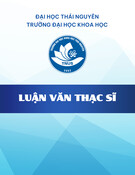
including countries such as the Andaman Islands, Australia, Indonesia, Thailand,
Malaysia, Singapore, Ryukyus (Japan), south and southeast China, Taiwan,
Philippines and Palau. In Vietnam, the sea bream is distributed in coastal areas from
the Gulf of Tonkin to the Gulf of Thailand, which the most in the waters of Quang
Thai (Thua Thien Hue), the lower Thu Bon River, and the alluvial plains of Quang
Ninh province. South, downstream of Hieu and Ben Hai rivers (Quang Tri).
The distribution area of scorpion fish is greatly affected by temperature. In the
wild, it is possible to catch fish in waters with temperatures ranging from 24-280C.
Dumplings are generally able to tolerate a wide range of temperature and salinity
variations [7]. Fish can adapt gradually when the salinity is low to 5 ‰, the
temperature is 25 - 340C. The ability to tolerate low dissolved oxygen is also very
good. However, fish cannot tolerate it if the dissolved oxygen content is < 2mg O2/L
[11].
Newly hatched peacock larvae have a small size of 1.5 - 1.6 mm. The larvae
open their mouth 36 hours after hatching, and start to eat at 60 hours after hatching, the
yolk is completely absorbed when the larvae are released. 70 hours after hatching [6].
In the first three days, larvae feed on yolk and oil drops, larvae start feeding 3 days
after hatching at 28 - 300C. In the larval stage, the fish feed mainly on zooplankton,
but in the juvenile and adult stage, it is completely fed by aquatic plants [14]. In the
wild, scads often eat plants on the seabed, head down, and can eat day and night [9].
Juvenile and adult stages: Like other species of scorpion, during juvenile and adult
stages, peacocks feed exclusively on aquatic plants [16].
Male and female sharks are difficult to distinguish based on appearance alone.
However, during the breeding season, it is possible to observe the abdomen to identify
the female by its round shape or visit the eggs, while the male when gently stroked
will have white discharge (semen). In addition, the males are usually smaller than the
females and the females are less active than males during the breeding season.
Crayfish can mature in captivity if environmental conditions are favorable and
provided with adequate and quality food [10, 13].
1.2. Situation of research on rabbitfish in the world and Vietnam
1.2.1. In the world
Research on the artificial reproduction of scads in captivity has been carried out
for a long time [12], especially after the 1972 Hawaiian conference on barnacles.
However, rearing was not successful from this stage. larval stage to the end of
metamorphosis. Most of the research on larva larvae has not been successful in the
early stages or if so, the survival rate is very low [18]. Some studies report survival
rate until complete metamorphosis is less than 1%. The survival rate was 9% in S.
vermiculatus and the most successful in S. lineatus [15]. In the years from 1981 to
1983, Juario et al. (1985) increased the survival rate when rearing larva until the end of
metamorphosis from 1.9% to 12.8%, but the results were not satisfactory. determined.
The author could not explain why the survival rates of 1982 and 1983 were worse than
those of 1981. In 1985, the study on spawning and rearing of larva in the Southeast































